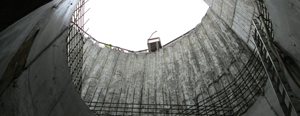 Significant excavation is needed to apply sheet membranes. Sometimes, this is not possible and the membrane needs to be added before the concrete, leading to a blindside application.
Significant excavation is needed to apply sheet membranes. Sometimes, this is not possible and the membrane needs to be added before the concrete, leading to a blindside application.
Traditional waterproofing methods encourage the use of positive-side waterproofing during construction. However, this requires access to the outside wall of the concrete structure. If excavation is not possible in some areas, the structure must have the waterproofing applied before the concrete is poured. This type of difficult application is called blindside waterproofing.
As cities around the world develop larger buildings on smaller plots of land to accommodate a growing population, blindside waterproofing is a growing issue for buildings using external membrane systems. In addition, if a building is attempting to achieve a higher “Green” rating, which continues to grow in popularity, excavation work needs to be kept to a minimum.
Don’t get blind-sided by space limitations – avoid applications altogether
Unlike old-fashioned external membranes, Krystol Internal Membrane (KIM) actually transforms the concrete into a water-resistant barrier. At any time before, during or after the construction of a below grade concrete foundation, KIM can solve the problem quickly and easily, because it is added directly to the concrete itself. When moisture is presented, KIM’s Krystol Technology reacts to grow long, narrow crystals to fill the pores and capillaries of the concrete mass. Traditional membranes are subject to deterioration and abrasion from the day they are applied, but integral crystalline waterproofing systems such as KIM permanently become a part of the concrete matrix.






